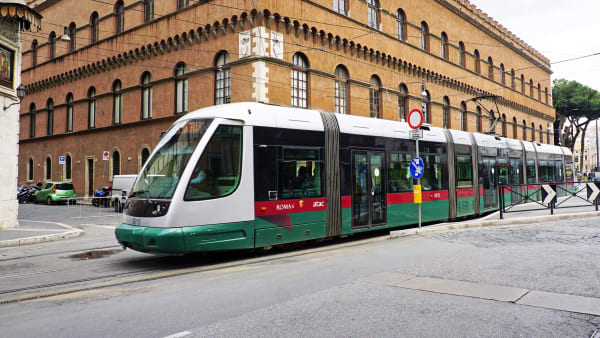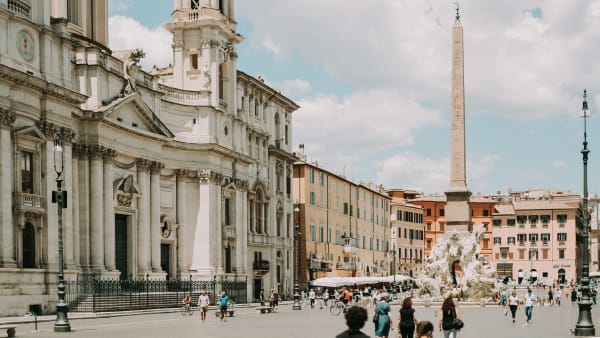Brief history
Brief history
The Palatine is the first of the seven hills of Rome that were inhabited. It’s located 40 meters above the Forum Romanum and looks down on it. On the other side of the hill is the Circus Maximus.
The name of the hill probably comes from the god Pales, who was worshipped during the festival of Parilia. This annual celebration took place on April 21, which is traditionally considered the day of the city’s foundation.
Monarchical period (753 to 509 BC)
The Palatine contains one of the most archaic remains of ancient Rome, consisting of, among other things, huts at various points on the hill (to the southwest) and a fortress wall on the north side, dating from the 8th century BC. Given its concurrence with the founding date of Romulus (753 BC), this detail is of particular interest.
However, the remains found of the oldest hut date from an earlier phase, from the period 900-750 BC, the Late Bronze Age and Early Iron Age, before the time of Romulus.
The Palatine and the Aventine faced each other as the two components of Roman society: the patricians on the Palatine and the plebeians on the Aventine.
According to some historians, Rome was founded in the middle of the eighth century (753 BC) by Romulus using rituals that would remain in place and force for the foundation of colonies until 1,000 years later.
It’s said that the founder dug a well from the top of the Aventine with a plow pulled by a cow and an ox. He was also said to build the walls, dig the moat and place the gates. The historian Tacitus describes this as the original form of Roma Quadrata: a quadrangular plan with the vertices at the Ara Massima di Ercole at the Forum Boario, at the Ara di Conso at the Circus Maximus, and finally at the shrine of the Lari cult, at the foot of the Velia.
The original wall consisted of large pieces of tuff mixed with earth. Later, the first wall was reinforced and partially replaced by another wall, consisting of two curtain walls filled with clay. From this period also dates the excavation of the outer moat, which was almost filled in the 6th century, when the new walls were built, to allow the doubling of the mighty walls of red tuff blocks.
At the end of the century, the new city plan of the Tarquins (Etruscan kings) was implemented. Four gates were opening onto the walls, but only two are known by name: the Mugonia gate on the road from the Palatine to Velia, later renamed Via Sacra, and the Romana or Romanula gate in the direction of the Velabro.
The Tarquins dramatically transformed the city from 616 to 509 BC. Tarquinius Priscus sat on the throne of Rome until 578 BC and had stone buildings covered with decorative terracotta, while the temples and streets were among the most beautiful and impressive in the entire Mediterranean. The Cloaca Maxima (sewer) was built, and the inscription of Lapis Niger indicates the spread of Latin as an official language, despite the significant presence of the Etruscans.
Around the middle of the 6th century, King Servius Tullius divided the enlarged urbe into four parts, and square terrace walls were built on the Palatine to provide stability for the new buildings with sewers. Public spaces were created and the archaic road network was modified by replacing the old river beds of pebbles with tuff blocks. The main road around the hill was the Via Sacra. At the top of the hill were the most important temples.
Republican period (509 - 27 BC)
The history of the Palatine is quite obscure during the first centuries of its existence and, except for a few temples such as the Temple of Victory and the Temple of Magna Mater, no public buildings were erected.
In the republic, however, the hill turned into a residential area of the Roman ruling class, with private houses and villas of wealthy and influential people such as M. Valerius Maximus (consul in 505 BC), Tiberius Sempronius Gracchus (politician), Licinius Crassus (consul in 95 AD), Cicero (statesman and philosopher), Catullus (first great Latin lyricist), Q. Hortensius Ortalo (speaker, lawyer, and consul).
Among the many palaces, which will be discussed in more detail in the next section of this article, the House of Livia stands out. Emperor Augustus lived here with his third wife, Livia. The building dates back to the 1st century BC and, despite being relatively modest, is one of the most beautiful and best-preserved imperial palaces.
Finally, in 44 BC, Augustus decided to move his residence, the House of Augustus, to the Palatine and build a temple in 28 BC dedicated to Apollo. Since then, almost all the emperors took up residence on the hill. Over time, more and more imperial palaces appeared on the hill overlooking the magnificent Forum Romanum.
The wealth of the imperial court was determined not only by the size of the residence but especially by the splendor of its decorations: colored marble on the walls and floors, elegant frescoes in the rooms, stucco with original and imaginative decorative motifs, etc. There were also statues, sculptures, and works of art scattered throughout the building and a dining room, the Cenatio Iovis, which was heated in winter.
Imperial period (27 BC - 476 AD)
With the succession of emperors, new residences were built one after another, such as the imperial palace of Tiberius or Domus Tiberiana (enlarged by Caligula), the palace of Nero, the Domus Transitoria, and part of the Domus Aurea (built after the Great Fire of Rome in 64 AD), etc.
The reputation of the hill was established when the sumptuous Palace of Domitian was built. This gigantic complex took up almost the entire surface of the hill.
The Palace of Domitian was divided into several parts: the baths and the stadium were for recreation; a private wing, the Domus Augustana, where the imperial chambers were located, divided into rooms with courtyards and terraces; and finally the public wing, the Domus Flavia, where the great throne room was located.
The building complex remained largely unchanged until the time of the Severians when Emperor Septimius Severus had a new section added, the Septizodium (or Septitentium). This is Latin for the temple of seven suns, referring to Saturn, Sun, Moon, Mars, Mercury, Jupiter, and Venus. It was a monumental, nymphaeum-like facade three stories high and was decorated with composite columns, numerous statues in niches, fountains, and plants. In the center niche was a statue of Septimius Severus.
After Septimius Severus, apart from a temple built by Heliogabalus in the 3rd century, no significant building was erected on the Palatine. At the beginning of the 4th century, the emperors even began to abandon the Palatine. The decline had already begun under Constantine and was only further encouraged by the abandonment of the ancient temples and the destruction in 410 by the Goths and in 455 by the Vandals.
Medieval era (476 - 1492)
During the Middle Ages, the Palatine underwent a major change and deteriorated into pasture land for herds. In the 500s, some functions of the palace were restored thanks to Theodoric, who carried out restorations and built an amphitheater in the stadium that Domitian had commissioned.
The former imperial residence, which housed the Byzantine administration, was used by emperors visiting Rome until the 7th century when the downstairs rooms were inundated by the mud left behind after the Tiber flooded.
After the decline of the Byzantine Duchy of Rome and the transfer of the pope’s seat to Lateran, the Palatine ceased to “exist,” although in the ninth and tenth centuries some villages arose near the churches. Some of the remaining buildings were converted into houses, and the hill aroused the interest of the di Imiza, di Papa and Stefaneschi families.
In addition, some churches were restored, such as St. Anastasia. Later, a monastery was founded in the Vigna Barberini and a church near the Settizonio. In the northern part of the Palatine stood the Cartularium of Testamentum, an archive of documents concerning church property.
Emperor Otto III chose the Palatine as his home. In the twelfth century, the hill was owned by a large family and religious bodies, while in the late Middle Ages it became depopulated and gave way to gardens, vineyards, and fields. In the monuments that were not used as homes, large excavations were carried out in search of material that would be made into lime.
The symbolic character of the Palatine again increased with the rise of the House of Frangipane, which settled near the Via Sacra and built towers and fortresses to control the main roads, which included the Arch of Titus.
Renaissance (1492 - 1789)
Another family that exercised its power on the hill was the Farnese family, who took the initiative to restore the Palatine to its former glory and had the Orti Farnesiani (Farnese Gardens) planted on the northern part of the hill, entrusting the project to Jacopo Barozzi da Vignola.
The green areas were interspersed with elegant buildings that are still partially preserved over the remains of the Domus Tiberiana. In addition, the gardens were intended to provide an exceptional assortment of rare and exotic plants.
As the influence of the Eastern Empire waned, papal authority increased. Thus, the church of San Sebastiano was built and the Settizonio was incorporated into the nearby abbey of San Gregorio, which shortly thereafter also occupied the Severiane baths. Another monastery on the Palatine was that of the monks of Montecassino, which came into being in the mid-14th century.
The last major change to the Palatine before the excavations that defined the current landscape and ruins was carried out by Pope Paul III, who in 1536 laid out the area of the Campo Vaccino and, after demolishing the buildings in the area, planted an avenue of elms between the Arch of Titus and the Arch of Septimius Severus, marking the ancient Via dei Trionfi.
Having purchased land and vineyards, the pope had luxurious gardens laid out at the top of the Palatine and ordered the construction of steps, fountains, nymphaea (a shrine dedicated to nymphs), and the planting of European and American species of trees.
Contemporary period (1789 - present)
In 1731, the Bourbons took possession of the gardens, which slowly fell into disrepair: abandoned by the owners who lived in Naples, the buildings were occupied by peasants who used the gardens for growing crops. Eventually, they came into the hands of Napoleon III and the Kingdom of Italy.
In 1830, Scotsman Charles Andrew Mills had a villa built, better known as Villa Mattei. Built on top of the Domus Augustana and the Domus Flavia, it was demolished in the early 20th century to allow for excavations of the archaeological site.
Intensive archaeological excavations in the area began in the 18th century and ended in the late 19th century after Rome was declared the capital of the Kingdom of Italy. Discoveries continued in the 20th century, such as the House of Augustus and the very recent discovery of underground space, possibly the Lupercal. The Palace of Tiberius, under the Farnese Gardens, remains unexcavated.
Although today only parts of the ancient structures still exist, these remains allow us to get an idea of the lifestyle of the time. One of the best-preserved complexes on the Palatine is the House of Augustus.
At the top of the hill is the Antiquarium of the Palatine: the museum that exhibits material from the Republican period (first floor) and the Imperial period (second floor).
Among the monuments are various objects from the Iron Age and works of art from imperial buildings. The most important of these works are the decorative paintings of the Aula Isiaca.















